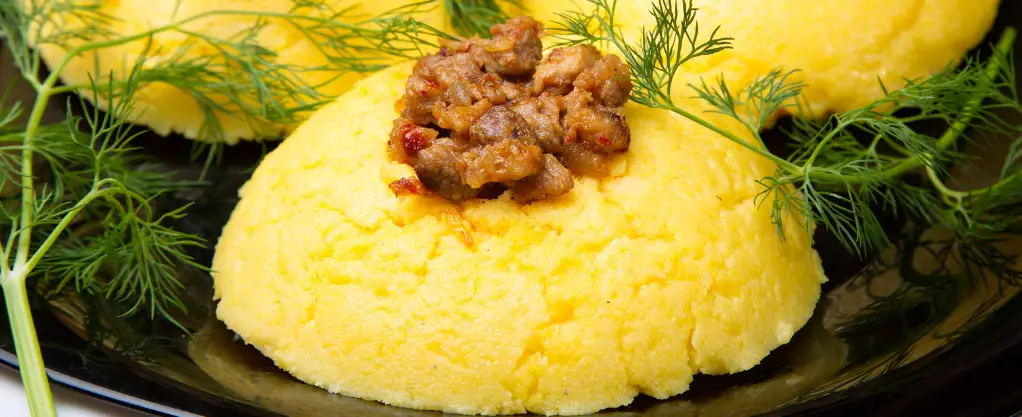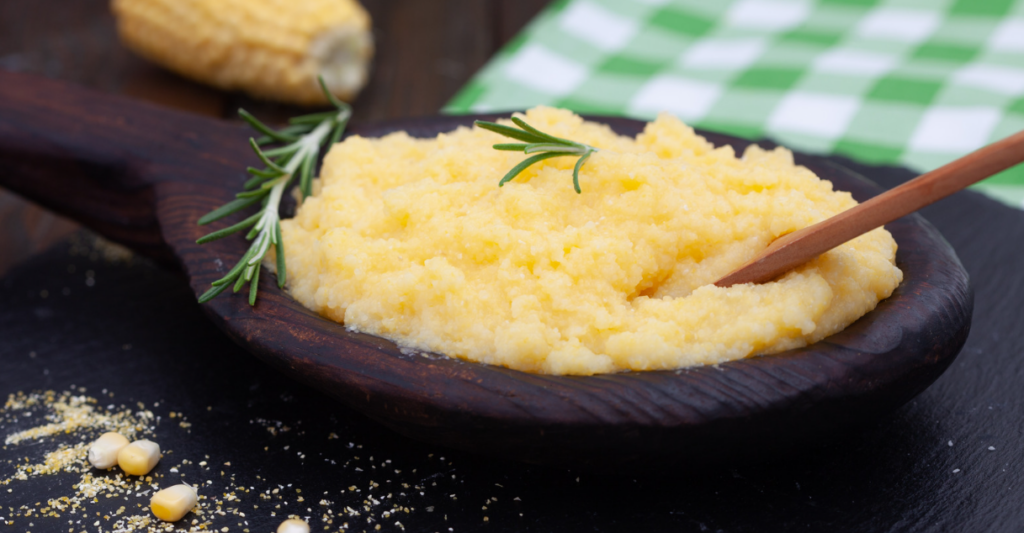Mămăligă and polenta, two seemingly distinct dishes, weave a common thread through the tapestry of European cuisine. Mămăligă, a staple in Romanian and Moldovan culinary traditions, stands out for its simplicity and versatility. Often regarded as the Romanian counterpart to the globally recognized Italian polenta, it plays a pivotal role in the region’s food culture. Polenta, originating from Italy, shares its basic composition with mămăligă, primarily consisting of cornmeal, yet it carves out its own unique identity and culinary applications. Both dishes, with their peasant origins, have transcended humble beginnings to find their way into gourmet restaurants worldwide. This article aims to unravel the intricate relationship between mămăligă and polenta, exploring their historical backgrounds, culinary uses, and the subtle nuances that set them apart, while also highlighting their remarkable similarities.
What is Mamaliga?
Definition and Origin
Mămăligă, a quintessential dish from Eastern Europe, predominantly graces the tables of Romania, Moldova, and Western Ukraine. Originating as a humble cornmeal porridge, it comprises yellow maize flour, reflecting the agricultural roots and resourcefulness of these regions.
Ingredients and Basic Preparation
The simplicity of mămăligă lies in its minimalistic approach to ingredients and cooking. It requires just cornmeal, water, and a pinch of salt. These ingredients are combined and cooked, resulting in a porridge that varies in texture. The consistency can be adjusted from a creamy, soft blend to a firmer, sliceable form, akin to a bread loaf.
Cultural Significance in Romanian Cuisine
In Romanian cuisine, mămăligă represents more than just a dish; it embodies a cultural emblem. Its presence in Romanian folklore and literature underscores its deep-rooted significance in the country’s culinary history. Today, mămăligă enjoys reverence for its versatility and rustic appeal.
What is Polenta?
Definition and Italian Origin
Polenta, a classic Italian dish, is known for its smooth, creamy texture. Originating from Northern Italy, polenta has become a beloved component of both traditional and contemporary Italian meals.
Comparison of Ingredients with Mamaliga
Polenta and mămăligă are similar in their fundamental ingredients: both are primarily made from cornmeal, water, and salt. The primary distinction lies in the cornmeal’s texture and the cooking technique, which imparts different consistencies and flavors to each dish. While mămăligă often has a thicker, sometimes coarser texture, polenta is typically smoother and creamier, reflecting the culinary preferences of its Italian origins.
Role in Italian Cuisine
In Italian cuisine, polenta often serves as a versatile base, either starring in a dish or complementing it as a side. Discover more about Polenta’s Role in Italian Cuisine.
Historical Background of Mamaliga and Polenta

Early History and Roman Influence
The historical roots of dishes like mămăligă and polenta can be traced back to ancient times, long before maize was introduced to Europe. Porridge, the earliest form of grain consumption by humanity, often involved various seeds like millet or einkorn. In Roman cuisine, a millet-based porridge known as ‘pulmentum’ was common, which over time evolved into dishes like mămăligă and polenta. This transformation highlights the adaptability of basic culinary concepts across cultures and ages.
Introduction of Maize in Europe and Its Impact
The introduction of maize into Europe marked a significant turning point. Brought from Mexico to Spain by Hernán Cortés in the 16th century, maize found its way across the continent, thriving particularly in regions like the Danube Valley, ideal for its cultivation. This new crop was quickly adopted into the local diets, giving birth to what we know today as mămăligă in Eastern Europe and polenta in Italy. The affordability and ease of cultivation of maize made it an essential ingredient in these regions, reshaping their culinary landscapes.
Transition from Peasant Food to Modern Culinary Appreciation
Initially, both mămăligă and polenta were considered peasant foods. Inexpensive and filling, they served as staples for the lower classes, particularly in rural areas. Over the years, however, both dishes have undergone a remarkable transformation in their cultural status. From humble beginnings, they have ascended to the menus of fine dining establishments, embraced for their rustic charm and versatility. This culinary elevation reflects a broader trend in the gastronomic world, where once-overlooked simple ingredients and dishes are now celebrated for their authenticity and potential for sophisticated culinary innovation. The journey of mămăligă and polenta from basic sustenance to gourmet fare encapsulates a fascinating aspect of food history, illustrating how tastes, perceptions, and culinary values evolve over time.
Comparison: Mamaliga vs. Polenta
Similarities in Ingredients and Preparation
Mămăligă and polenta share remarkable similarities in their core ingredients and basic preparation methods. Both dishes are predominantly made from cornmeal, water, and salt, embracing the essence of culinary simplicity. The process of cooking these dishes involves boiling water, gradually stirring in the cornmeal, and cooking it to the desired consistency. This straightforward method underscores the shared heritage and simplicity at the heart of these comfort foods.
Differences in Texture and Regional Variations
Despite their similar base, mămăligă and polenta exhibit notable differences, primarily in texture and regional adaptations. Mămăligă, traditionally found in Romania and neighboring regions, tends to have a slightly coarser texture. It can range from soft and creamy to firm and sliceable, depending on the ratio of water to cornmeal used in preparation. Polenta, on the other hand, is typically creamier and smoother, a characteristic favored in Italian cuisine. These textural differences, although subtle, are significant in distinguishing the two dishes and reflect the culinary preferences of their respective cultures.
Popular Pairings and Ways to Serve
Both mămăligă and polenta boast incredible versatility in terms of serving. Chefs often serve mămăligă with rich stews, sausages, or as a bread alternative. Its adaptability shines when topped with cheese and sour cream, accommodating a variety of flavors. In Italian cuisine, chefs frequently pair polenta with robust sauces, meats, and vegetables, allowing it to perfectly absorb and complement these strong flavors. Moreover, polenta’s versatility shines through its ability to be grilled, fried, or baked, establishing it as a staple in various Italian dishes. The ways chefs serve mămăligă and polenta not only highlight their versatility but also demonstrate their ability to blend seamlessly into the culinary fabric of their respective cultures, forming an integral part of the dining experience.
Nutritional Aspects and Dietary Considerations

Health Benefits and Potential Concerns
Mămăligă and polenta, primarily composed of cornmeal, offer several health benefits, making them valuable components of a balanced diet. They are naturally gluten-free, which is beneficial for individuals with gluten sensitivities or celiac disease. Rich in carbohydrates, they provide a good source of energy. Additionally, cornmeal contains essential minerals like magnesium, selenium, and some B vitamins, contributing to overall nutritional intake. However, being high in carbohydrates, they may not be suitable for low-carb diets.
However, there are potential concerns to consider. Being high in carbohydrates, they may not be suitable for low-carb diets. Furthermore, the nutritional value can be significantly altered depending on what they are paired with or how they are prepared. For instance, adding high-fat or high-sodium ingredients can diminish their health benefits.
Role in Traditional Diets
In traditional diets, both mămăligă and polenta have played crucial roles as dietary staples. Their high carbohydrate content made them an excellent energy source, particularly important in labor-intensive rural communities. In regions where mămăligă is prevalent, it often served as the main carbohydrate source, especially in poorer areas where wheat flour was less accessible. Similarly, polenta in Italian diets was a staple food, particularly in the northern regions, providing a versatile and affordable source of energy.
In contemporary diets, while they still hold a significant place, the way they are consumed has evolved. With a growing emphasis on balanced eating, mămăligă and polenta are often part of a more varied diet, paired with proteins, vegetables, and other nutrients to create well-rounded meals. This evolution reflects a broader shift towards diverse and health-conscious eating habits, while still maintaining the cultural and historical essence of these cherished dishes.
Modern Culinary Uses of Mamaliga and Polenta
Contemporary Dishes and Innovations
In the modern culinary landscape, both mămăligă and polenta have transcended their traditional roles, inspiring a plethora of contemporary dishes and culinary innovations. Mămăligă, once a simple, rustic dish, is now featured in various forms, from the classic porridge to more creative adaptations like mămăligă cakes or fritters. Chefs are experimenting by incorporating it into modern cuisine, using it as a base for avant-garde appetizers or as an inventive side dish, sometimes enhanced with luxurious ingredients like truffles or gourmet cheeses. For a deeper understanding of Mămăligă’s evolution in contemporary cuisine, explore Mămăligă: A Culinary Journey Through Tradition and Innovation.
Polenta has seen a similar evolution, becoming a canvas for culinary creativity. It is no longer just a side dish; it’s an integral part of sophisticated recipes. Polenta is used in fine dining as a base for elegant entrées, served with gourmet sauces, or topped with high-quality meats and seafood. Its versatility is also showcased in desserts, where sweetened polenta serves as a unique and delightful base for fruit compotes and creamy toppings.
Mamaliga and Polenta in Fine Dining
Mămăligă and polenta have risen from simple beginnings to fine dining stars. Top chefs globally are now using these dishes for their versatility and comfort. Mămăligă is often seen deconstructed or in fusion dishes. It combines traditional Romanian tastes with global flavors.
In gourmet Italian cuisine, polenta is a staple. It’s frequently found on upscale menus. Its compatibility with luxury ingredients and varied textures is notable. It ranges from creamy to crispy. This gourmet shift for mămăligă and polenta highlights their flexibility. It also shows a growing respect for rustic, grain-based foods. They have moved from peasant origins to icons of culinary elegance.
FAQs
Q1: Is mamaliga the same as polenta?
A1: Mamaliga and polenta are very similar, both being cornmeal-based porridges. They share common ingredients – cornmeal, water, and salt – and have a similar preparation method. However, there are subtle differences in texture and regional culinary practices. Mamaliga, originating from Romania, can be a bit coarser, while polenta, from Italy, is typically smoother.
Q2: What is the difference between mamaliga and grits?
A2: The distinction between mamaliga and grits primarily comes from the type of cornmeal used and their textures. Manufacturers use yellow cornmeal to make mamaliga and polenta, offering textures ranging from creamy to firm. Conversely, grits, a staple in the Southern United States, come from white corn (hominy) and usually have a creamier and smoother texture.
Q3: Can polenta be used as a substitute for mamaliga?
A3: Yes, one can often use polenta as a substitute for mamaliga in recipes because they share similar base ingredients and cooking methods. The dish made with polenta will have a slightly different texture and flavor but will generally serve as a suitable replacement.
Q4: Are mamaliga and polenta gluten-free?
A4: Yes, both mamaliga and polenta are naturally gluten-free since manufacturers make them from cornmeal. However, one should consider the risk of cross-contamination in facilities that also process gluten-containing grains.
Conclusion
In summary, mămăligă and polenta, while distinct in their cultural origins and culinary traditions, share remarkable similarities. Both are cornmeal-based porridges that have evolved from humble peasant foods to versatile components of modern gastronomy. The differences, mainly in texture and regional culinary preferences, are subtle yet significant in distinguishing each dish’s unique identity. This exploration into mămăligă and polenta reveals the profound impact of simple ingredients in shaping culinary history and culture. Ultimately, these dishes exemplify how food transcends boundaries, connecting us to different cultures and histories through shared ingredients and cooking methods.
